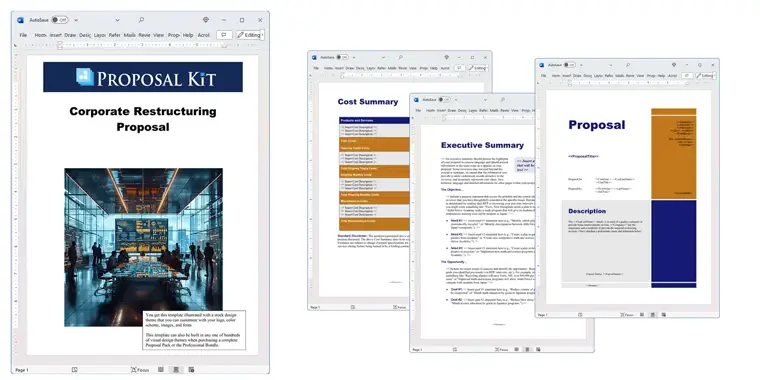How to write your Corporate Restructuring Proposal
We include this 26 page layout with every Proposal Pack. If you want this template to have a different visual design theme than the one illustrated here, purchase any Proposal Pack design and create this template using the purchased design theme. This template is included in every Proposal Pack. If you get a Proposal Pack or the Professional Bundle, you can also make any variation of this template with different chapters to suit your needs.
We typically include more chapters in the templates than most people will need to give everyone more variety in the chapters they may need. You can trim down a long template by removing pages you do not need or combining multiple chapter topics into one page.
 DOWNLOADABLE, ONE-TIME COST, NO SUBSCRIPTION FEES
DOWNLOADABLE, ONE-TIME COST, NO SUBSCRIPTION FEES If you need this template on DVD media order from our Amazon shop.
If you need this template on DVD media order from our Amazon shop.
You can also create countless variations of this document to suit your needs using the included library of 2200+ chapters if ordering a Proposal Pack or Pro Bundle.
 What Our Clients Say
What Our Clients SayThese proposals have helped to simplify the workflow in our company, they are also easy to use and affordable for any business."
POPex Limited
Related Article
Related Video
Related Templates
- Business Plan to Restart Shuttered Business
- Relocate Manufacturing Domestic Proposal
- Process Improvement Proposal
- Business Management Proposal
- Retraining Workers Skills Development Proposal
- Labor Cost Management Proposal Template
- Community Impact Mitigation Proposal Template
- Organizational Development Proposal
- Due Diligence Project Proposal
- Growing Company Globally Proposal
- Downsizing Company Cost Savings Proposal
- Failing Business Turnaround Proposal
- Organizational and Managerial Structure Report
- Market Access Recovery Proposal Template
- Workforce Efficiency Proposal Template
Writing Your Corporate Restructuring Proposal with Proposal Kit
Writing a corporate restructuring proposal can seem like a mountainous task. A proven way to navigate this challenge is to leverage the Proposal Kit template library and Wizard software program. This comprehensive toolkit simplifies the proposal writing process, integrating a line item quoting database system for detailed financial discussions, including cost summaries, quotes, estimates, budgets, and more. So, how exactly can Proposal Kit transform this task into a manageable one?
Are you currently facing the challenge of writing a proposal for a corporate restructuring project? If so, the Proposal Kit is designed to guide you through the process, providing the tools and templates necessary to articulate your vision and strategy effectively.
What Types of Projects Are Corporate Restructuring Proposals Written For?
Corporate restructuring encompasses many projects to enhance efficiency and reduce operational costs. These projects can range from redefining organizational roles to optimizing resource allocation. Here are some examples of typical corporate restructuring projects:
- Merging departments to streamline operations
- Outsourcing non-core business functions
- Implementing new technologies for efficiency
- Reducing workforce while minimizing the impact on productivity
- Consolidating office spaces or relocating for cost efficiency
- Revising supply chain operations for cost savings
- Implementing flexible work arrangements
- Restructuring management to improve decision-making
- Refinancing debt to lower interest payments
- Rebranding to align with new company directions
Chapters this template is built with
Proposal Kit offers a wide range of templates to cover every aspect of your proposal, ensuring every detail is noticed. Here's how specific Proposal Kit chapters can enhance your corporate restructuring proposal.
These templates, available as Word format documents, are just a starting point. You can customize your proposal, adding or removing sections as needed, and once complete, save it as a PDF file for easy sharing.
Cover Letter
The cover letter serves as the opening handshake of your corporate restructuring proposal. It's your first opportunity to connect personally with the reader, setting the tone for what's to come. Here, you introduce your proposal, briefly mention the objectives, and express your enthusiasm for the potential partnership. A well-written cover letter captivates the reader's interest and demonstrates your professionalism and keenness to collaborate on achieving the proposed restructuring goals.
Executive Summary
The executive summary is your proposal's elevator pitch. It needs to succinctly capture the essence of your restructuring plan and outline the key points that will be detailed later. This section should be compelling, providing a clear snapshot of the problem, the proposed solution, and the expected outcomes. It's your chance to convince stakeholders of the necessity and viability of the restructuring and encourage them to read further. The Executive Summary may be the only page a high-level executive reads before passing the proposal to the teams that will digest the details.
Needs Assessment
A thorough needs assessment lays the groundwork for your proposal. It involves a deep dive into the current organizational challenges and inefficiencies, backed by concrete data and examples. This section should clearly articulate the issues and demonstrate a comprehensive understanding of the situation. By identifying these needs accurately, you will lay a solid foundation for the proposed restructuring solutions.
Pros and Cons
Discussing the pros and cons of your proposed changes offers a balanced view of the restructuring plan. This honesty helps in building trust with your stakeholders. Highlight the potential benefits, such as cost savings and increased efficiency, while acknowledging possible drawbacks or risks. This approach ensures that decision-makers are fully informed and can weigh the advantages against the disadvantages.
Present Situation
Describe your organization's current state, including its structure, processes, and challenges. This section serves as a baseline from which the need for restructuring is justified. A detailed picture of the present situation helps stakeholders understand the context and necessity for change, setting the stage for the proposed solutions.
Goals and Objectives
Clearly articulate the restructuring's goals and objectives. What do you aim to achieve? Goals include improved operational efficiency, cost reduction, enhanced competitive edge, or better resource allocation. Objectives should be SMART: specific, Measurable, Achievable, Relevant, and Time-bound. This clarity helps align all stakeholders around common aims, providing a clear direction for the restructuring efforts.
Benefits
It is crucial to highlight the anticipated benefits from the restructuring. These range from financial savings and increased market responsiveness to improved employee morale and customer satisfaction. This section should paint a compelling picture of the positive changes that the restructuring will bring, helping to garner support from key stakeholders.
Action Plan
The action plan outlines the steps required to implement the restructuring, including timelines, responsible parties, and needed resources. This roadmap should be detailed and clear and provide a practical guide to implementing the proposal. A well-structured action plan reassures stakeholders that the restructuring can be executed smoothly and effectively.
Reductions
If the restructuring involves workforce or cost reductions, explain these decisions with sensitivity and detail. Discuss how these reductions are necessary for the organization's long-term health and how they will be managed ethically and with respect for affected individuals. Transparency in this section helps to manage expectations and mitigate potential concerns.
Productivity Improvement
Describe how the proposed changes will enhance organizational efficiency and productivity. This might involve new processes, technologies, or structures that allow for more effective work practices. Specific examples and evidence-based projections can help convince stakeholders of the restructuring's expected tangible improvements.
Restructuring
This section should detail the specific organizational changes proposed, such as departmental realignments, leadership adjustments, or operational shifts. It should explain the restructuring's nuts and bolts and offer a clear vision of the post-restructuring organization. The more detailed and clear this vision, the easier for stakeholders to understand and support the changes.
Time Line
A timeline for implementing the restructuring plan provides a clear change schedule. It should include key milestones, deadlines, and phases of the restructuring process. A realistic and well-thought-out timeline is essential for managing expectations and coordinating the various aspects of the restructuring.
Entities Affected
Identify which parts of the organization will be impacted by the restructuring. This might include specific departments, teams, or locations. Understanding the scope of impact is crucial for planning change management strategies and communicating effectively with all stakeholders involved.
Analysis
Offer data and analysis to support your proposal, including financial figures, market trends, or case studies of similar successful restructuring efforts. Solid evidence and logical reasoning add credibility to your proposal and demonstrate that the proposed changes are theoretically sound, viable, and beneficial in practice.
Efficiency
Discuss how the changes will improve operational efficiency through streamlined processes, eliminating redundancies, or better resource utilization. Efficiency improvements are often a key driver of restructuring efforts, so detailing how these will be achieved can be a persuasive element of your proposal.
Cost Analysis & Cost Savings
This section of your proposal details the financial implications of the proposed restructuring. Break down the costs of implementing the plan, such as severance packages, training for new roles, and technology upgrades. Then, juxtapose these with the anticipated savings and financial gains. This could include long-term payroll reductions, decreased overheads, and efficiencies gained from streamlined operations. Use precise, quantifiable data to project how these changes will impact the bottom line over time. Anticipated savings should be presented as numbers and in the context of strategic financial health, showing how they reinvest into the organization's growth and stability.
Recommendations
Here, crystallize your proposal by stating your final recommendations. This should be a decisive and authoritative conclusion drawn from the analysis and discussions in the proposal. Outline the specific actions you advise the organization to take, prioritizing them according to their impact and feasibility. Also, suggest a timeline for implementation, considering any dependencies or critical milestones. Your recommendations should reflect a holistic understanding of the organization's goals, identified needs, and the benefits of the restructuring, guiding decision-makers towards informed action.
Company Operations
Discuss how the restructuring will affect company operations, focusing on changes to processes, systems, and workflows. Detail any shifts in operational priorities, introducing new technologies, or eliminating redundant processes. This section should articulate how the restructuring will lead to more efficient, agile operations that directly contribute to the organization's strategic objectives. Highlight how these changes will improve service delivery, product quality, or customer satisfaction, ultimately supporting the business's competitive advantage.
Executive Support
Emphasize the importance of executive support for the restructuring process's success. Outline the role of leadership in driving change, from communicating the vision to ensuring resources are appropriately allocated. Discuss how executives will need to champion the restructuring, address concerns, and motivate the workforce throughout the transition. Executive support is crucial for fostering a culture of adaptability and resilience, ensuring the organization navigates the restructuring with unity and purpose.
Workforce
Address how the restructuring will impact the workforce, including changes to job roles, departmental structures, and potential staff reductions or expansions. Discuss the plan for managing these changes, such as retraining programs, redeployment opportunities, or support for those leaving the company. Highlight how the restructuring is designed to position the workforce strategically for the organization's future needs, emphasizing the value of human capital in achieving long-term success.
Organizational Structure
Delve into the specifics of how the organizational structure will be modified. Describe any proposed reconfiguration of departments, creation of new units, or consolidation of functions. Explain how these changes enhance coordination, decision-making, and responsiveness to market or operational demands. This section should provide a clear before-and-after picture of the organizational structure, demonstrating how the restructuring will create a more coherent, streamlined entity.
Leadership
Conclude with a discussion on the impact of restructuring on leadership roles and responsibilities. This might involve the introduction of new leadership positions, changes to existing roles, or a redefinition of leadership competencies to align with the organization's new direction. Emphasize the critical role of effective leadership in steering the organization through change, maintaining morale, and building a culture that embraces innovation and continuous improvement. Highlight the investment in leadership development as a critical component of the restructuring plan, ensuring leaders are equipped to drive success in a restructured organization.
Use cases for this template
Marco's Strategic Turnaround with Proposal Kit
Marco's was at a critical juncture for his IT company. Despite having a passionate team and delivering high-quality services, the business faced mounting challenges. Client retention rates were slipping, project deadlines were increasingly missed, and internal processes needed to be more manageable and efficient. To steer his company back on course, Marco recognized the need for a significant shift, and he identified a strategic reorganization as essential.
Marco turned to the Proposal Kit to outline a comprehensive reorganization strategy. The first step was conducting a thorough analysis of the company's operations to pinpoint the root causes of inefficiency and client dissatisfaction. He assessed his company's current state, including workflows, team structures, and project management practices.
With the issues mapped out, Marco used Proposal Kit to draft a reorganization proposal. The proposal laid out a plan for restructuring the company into more specialized teams, aiming to enhance focus on core competencies and improve project turnaround times. It also proposed adopting new project management software to streamline processes and improve communication both internally and with clients.
Furthermore, the proposal outlined a new training program for staff to boost their skills in emerging technologies, ensuring the company could meet the evolving needs of the IT sector. Marco included a detailed timeline and milestones to track the reorganization's progress, using Proposal Kit's templates to ensure every plan aspect was communicated and actionable.
Implementing the reorganization plan had transformative outcomes. The company saw marked improvements in project delivery times, client satisfaction rates rebounded, and the team felt more engaged and empowered in their roles. Marco's strategic use of Proposal Kit enabled him to navigate his company through a period of uncertainty and lay the foundation for sustained growth and success.
Jamie's Just-in-Time Delivery
Jamie found herself in a race against time, tasked with developing a comprehensive corporate restructuring proposal. The deadline was tight, the expectations were high, and the proposal's scope required a depth of analysis and strategic foresight that seemed overwhelming. Recognizing the need for efficiency and precision, Jamie turned to Proposal Kit, a tool she hoped would streamline the process.
The Proposal Kit provided a structured framework, but Jamie knew she needed more to meet her deadline without sacrificing quality. She integrated AI tools to assist with specific sections of the proposal, using strategic prompts to guide the AI in generating insightful content. This innovative approach allowed her to leverage her company's resources and data more effectively. For instance, by feeding the AI information from her company's website and other documentation, she could write a Present Situation analysis and Needs Assessment that were comprehensive and aligned with her company's voice.
The combination of Proposal Kit's methodical structure and the AI's speed and adaptability resulted in a thorough, compelling, and timely proposal. Jamie met her boss's deadline and delivered a proposal that stood out for its clarity and depth of insight, earning accolades from her team and superiors.
Alex's Approach: A Non-Profit's New Direction
Leading a well-respected but traditionally structured international non-profit, Alex recognized the urgent need for change. While the organization was successful in its missions, operational inefficiencies and challenges hindered its potential impact. With a vision for a leaner, more effective organization, Alex faced the daunting task of proposing a comprehensive corporate restructuring.
Understanding the complexity of persuading an organization set in its ways, Alex employed the Proposal Kit to articulate her vision. The Proposal Kit enabled her to clearly lay out her restructuring plan, organizing her proposals into logical, persuasive sections that systematically addressed the anticipated concerns and questions of her executive board.
Alex's proposal detailed a strategic plan for restructuring that included realigning resources, adopting new technologies, and shifting towards more agile project management methods. It emphasized not only the financial benefits of such a restructuring but also its potential to enhance the organization's impact on its core mission areas.
Alex secured the executive support needed to embark on the restructuring process by presenting a clear, data-backed, and compelling argument for change. The Proposal Kit helped her transform her vision into a tangible, actionable plan, setting the non-profit on a new, more promising path to achieving its goals.
Conclusions and Recommendations
Proposal Kit is an indispensable tool for writing a successful corporate restructuring proposal. Proposal Kit empowers individuals and organizations to present their restructuring plans convincingly. Whether you're a seasoned professional or new to proposal writing, Proposal Kit can guide you through the process, ensuring your proposal is clear, comprehensive, and compelling.
Also Known As
This template may also be referred to in different ways or be used in more specialized situations, such as:
- Organizational Redesign Plan
- Business Transformation Strategy
- Corporate Realignment Initiative
- Enterprise Restructuring Scheme
- Operational Overhaul Proposal
- Company Reorganization Blueprint
- Corporate Revamp Strategy
- Business Model Reengineering Proposal
- Structural Reform Plan
- Operational Optimization Framework
Abstract
 Proposal Kit offers a comprehensive toolkit designed to simplify the complex task of writing a corporate restructuring proposal. This resource assists companies in clearly articulating their restructuring strategy. By using the templates and Wizard software, businesses can address various restructuring needs such as financial restructuring, operational restructuring, and organizational restructuring. These proposals often tackle issues like existing debt and unprofitable business units, aiming to enhance overall efficiency, reduce operating costs, and achieve goals. By restructuring, companies can better meet debt obligations, reduce their debt burden, and ensure financial stability. The Proposal Kit provides the necessary structure to present plans for turnaround management, alliances, or even joint ventures, helping organizations stay competitive in challenging economic downturns.
Proposal Kit offers a comprehensive toolkit designed to simplify the complex task of writing a corporate restructuring proposal. This resource assists companies in clearly articulating their restructuring strategy. By using the templates and Wizard software, businesses can address various restructuring needs such as financial restructuring, operational restructuring, and organizational restructuring. These proposals often tackle issues like existing debt and unprofitable business units, aiming to enhance overall efficiency, reduce operating costs, and achieve goals. By restructuring, companies can better meet debt obligations, reduce their debt burden, and ensure financial stability. The Proposal Kit provides the necessary structure to present plans for turnaround management, alliances, or even joint ventures, helping organizations stay competitive in challenging economic downturns.
Corporate restructuring is an initiative undertaken by businesses to reorganize their internal structure, operations, and financial topics. It can involve various approaches, such as out-of-court restructuring, debt for equity swaps, or implementing mergers and acquisitions to streamline business operations. The process often requires data-driven decisions to optimize core processes and reduce non-important assets. Companies have used restructuring to manage financial distress and improve their balance sheet health. A successful restructuring effort can lead to raising cash, improving cash flows, and reducing interest rates, ultimately leading to financial success. The Proposal Kit helps guide companies through each stage, from developing an initial proposal to executing the final stage of restructuring. By addressing the needs of corporate stakeholders, including existing shareholders, creditors, and investors, businesses can align their restructuring efforts with their direction, ensuring a more competitive, agile, and financially sound future.
Corporate restructuring is an important strategy used by businesses to address issues such as financial distress and declining competitiveness. This process entails a detailed assessment of the company's assets, liabilities, and internal operations, often with the purpose of repaying creditors and reducing debt obligations. Through organizational restructuring, companies can realign their internal structure, streamline business units, and enhance core processes.
 The Proposal Kit serves as a vital tool in creating a restructuring proposal, offering templates that guide businesses in articulating their goals and desired outcomes. Companies facing challenges such as bankruptcy protection or insolvency can use this toolkit to propose effective solutions like debt restructuring, operational optimization, or forming partnerships. By engaging in turnaround management, firms can explore options such as alliances or joint ventures, which often lead to improved financial stability and reduced operating costs.
The Proposal Kit serves as a vital tool in creating a restructuring proposal, offering templates that guide businesses in articulating their goals and desired outcomes. Companies facing challenges such as bankruptcy protection or insolvency can use this toolkit to propose effective solutions like debt restructuring, operational optimization, or forming partnerships. By engaging in turnaround management, firms can explore options such as alliances or joint ventures, which often lead to improved financial stability and reduced operating costs.
For businesses in decline, the Proposal Kit facilitates the development of a comprehensive plan, including components such as a cover letter, executive summary, and needs assessment. These topics are crucial for convincing corporate stakeholders of the restructuring's potential benefits, such as tax advantages, increased liquidity, or enhanced company culture. The proposal may also address the possibility of downsizing or selling non-core assets to raise funds and cut costs.
In the field of mergers and acquisitions, restructuring can involve complex negotiations and transactions, such as debt for equity swaps or the acquisition of new entities. The Proposal Kit helps businesses outline these processes methodically, ensuring compliance with the bankruptcy code and other regulatory requirements. By using these resources, companies can maintain a controlling stake in their operations, achieve financial success, and ensure their long-term viability in the industry.
 Overall, the Proposal Kit helps companies navigate the intricacies of restructuring with confidence, enabling them to adapt to changing market conditions, enhance operational efficiency, and secure a sustainable future. By focusing on direction and using existing resources, organizations can transform potential failures into opportunities for growth and innovation.
Overall, the Proposal Kit helps companies navigate the intricacies of restructuring with confidence, enabling them to adapt to changing market conditions, enhance operational efficiency, and secure a sustainable future. By focusing on direction and using existing resources, organizations can transform potential failures into opportunities for growth and innovation.
Frequently Asked Questions
What should be included in a corporate restructuring proposal?
A corporate restructuring proposal should include a clear executive summary, the objectives of the restructuring, a detailed analysis of the current organizational structure, the proposed new structure, a timeline for implementation, financial projections, risk assessment, and a communication plan. Each section should provide comprehensive information to ensure stakeholders understand the restructuring's rationale, benefits, and anticipated outcomes.
How do I identify the key areas that need restructuring?
Identifying critical areas for restructuring involves conducting a thorough analysis of your current operations, financial performance, and market position. This may include reviewing organizational inefficiencies, redundant roles, declining revenue streams, and changing market conditions. Consulting with department heads and conducting SWOT (Strengths, Weaknesses, Opportunities, Threats) analyses can also provide valuable insights into areas that require attention.
How can I ensure stakeholder buy-in for the restructuring proposal?
Ensuring stakeholder buy-in requires clear and transparent communication about the reasons for restructuring and its benefits. Engaging stakeholders early in the process and addressing their concerns can build trust and support. Providing detailed data and projections that illustrate the positive impact of the restructuring, along with a well-thought-out implementation plan, can help persuade stakeholders of the proposal's merit.
What are the risks associated with corporate restructuring, and how can they be mitigated?
Common risks include employee resistance, operational disruptions, financial strain, and loss of key personnel. These risks can be mitigated through comprehensive planning, effective communication, and phased implementation. Developing a risk management plan that includes contingency strategies, regular progress reviews, and employee support programs can help manage these challenges effectively.
How do I measure the success of a corporate restructuring?
Measuring the success of a corporate restructuring involves setting clear, quantifiable goals and tracking performance against these benchmarks. Key performance indicators (KPIs) include increased profitability, improved efficiency, market share growth, and employee satisfaction. Regularly reviewing these metrics and comparing them to pre-restructuring data can provide insights into the effectiveness of the restructuring efforts. Additionally, seeking feedback from employees and customers can offer a qualitative perspective on the impact of restructuring.
15% Off Discount
![]() Add To Cart This Word Template Only
Add To Cart This Word Template Only
 Add To Cart Proposal Pack for Any Business
Add To Cart Proposal Pack for Any Business
 Add To Cart Proposal Kit Professional Bundle
Add To Cart Proposal Kit Professional Bundle
 4.7 stars, based on 846 reviews
4.7 stars, based on 846 reviewsProposal Kit chapters used in this template
Cover Letter, Title Page, Table of Contents, Executive Summary, Needs Assessment, Goals and Objectives, Present Situation, Restructuring, Executive Support, Leadership, Organizational Structure, Workforce, Company Operations, Entities Affected, Reductions, Productivity Improvement, Benefits, Pros and Cons, Analysis, Efficiency, Cost Analysis, Cost Savings, Recommendations, Time Line, Action Plan, Back Page
Included Calculator Spreadheets
These Excel calculator spreadsheets are included with this template. If you purchase a Proposal Pack or the Professional Bundle, these proposal pages are generated using an automated line-item database in the included Wizard software. The calculator spreadsheets are intended for use when purchasing only the static Word template.
You use this proposal for
- General business proposal
- Non-technical proposal
- Project pitch proposal
- Internal company proposal
How to create this template with Proposal Pack Wizard
You can create this document using any of the logo-designed Proposal Packs. Pick any Proposal Pack with a logo design theme you like best; they will all work equally well. The Proposal Pack for Any Business is the pack with no extra added logos or colors - designed to be used plain or for you to customize with your logos and graphics.
The Proposal Pack design theme you purchase will determine the visual look of this template. The screenshot above only shows the plain generic design theme. Names and stories in examples are fictional; however, the templates are from real client use cases.
We include a library of chapters to be assembled based on your needs. All proposals are different and have different needs and goals. We designed Proposal Pack so you can customize the documents to suit your needs.
You will best create this document using the Proposal Pack Wizard - Expert Edition software to select this template and build it in the Proposal Pack logo design theme of your choice along with any desired customizations (such as adding additional chapters, removing unneeded chapters, changing the order of chapters, and importing your company logo). This template outlines a proposal for the described situation. Each user is responsible for typing in the actual content of the provided pages with their information to complete the proposal. Suggestions in the abstract may include features in higher-end packages and are facilitated by the selection of chapter templates to support the narrative of each proposal, which help guide the user in filling in the details.
You create this template using the Wizard software with an entire Proposal Pack library and software. We include the Expert Edition of the software in the Proposal Kit Professional bundle. Microsoft Word for Windows is required to use the customizing software. You can also edit Word document templates in other office software such as Word for Mac. We will assist Mac users in assembling complex templates for their first project if they do not have the required platform to run the Wizard software.
You only get the single assembled Word document if purchased as a stand-alone template. The individual template products include no other templates, samples, or software.
How to Build Templates Featured on Proposal Kit Website
Many people find the Proposal Kit website after searching for a specific proposal. Once you've purchased and installed the software, how do you build that template you found in the first place? This video shows you how to build any proposal you see on the Proposal Kit website.
Key Takeaways
- The Corporate Restructuring Proposal is available as a ready-to-edit template.
- You can create unlimited custom variations of this template using a Proposal Pack or the Professional Bundle.
- Using a Proposal Pack or Professional Bundle, you can automate quotes and other financial pages with a line-item database.
- There are no ongoing subscription fees. You get lifetime unlimited use.
- We made Proposal Kit for freelancers, small businesses, and non-profits.
- Proposal Kit product content (templates, samples, software) is 100% written by humans.
 Ian Lauder has been helping businesses write their proposals and contracts for two decades. Ian is the owner and founder of Proposal Kit, one of the original sources of business proposal and contract software products started in 1997.
Ian Lauder has been helping businesses write their proposals and contracts for two decades. Ian is the owner and founder of Proposal Kit, one of the original sources of business proposal and contract software products started in 1997.By Ian Lauder
 Published by Proposal Kit, Inc.
Published by Proposal Kit, Inc.


 Cart
Cart


 Get 15% off ordering today:
Get 15% off ordering today: 

 Facebook
Facebook YouTube
YouTube X
X Search Site
Search Site